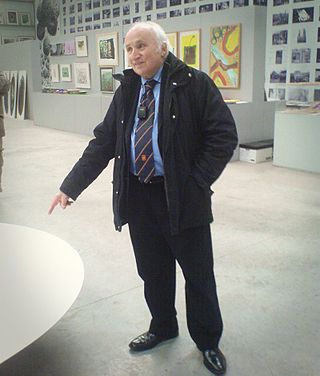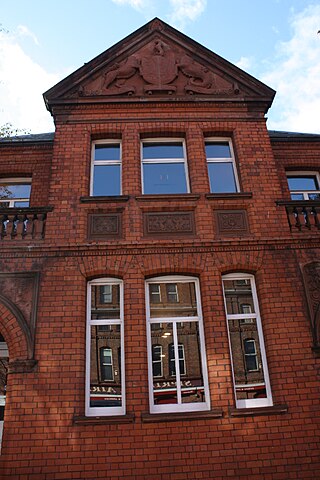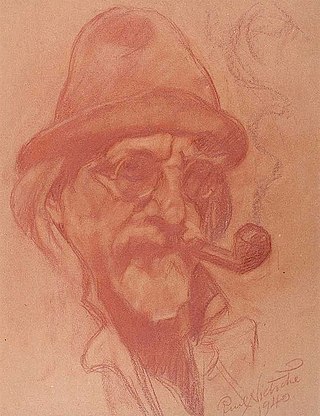Related Research Articles
Basil Joseph BlackshawHRUA, HRHA was a Northern Irish artist specialising in animal paintings, portraits and landscapes and an Academician of the Royal Ulster Academy.

Richard Demarco CBE is a Scottish artist and promoter of the visual and performing arts.

Victor Sloan MBE is a Northern Irish photographer and artist.

The Ormeau Baths in Belfast, Northern Ireland, now a home to tech and digital businesses in a modern contemporary building, was one of Ireland's premier contemporary art spaces. It curated exhibitions by prominent international artists including; Yoko Ono, Gilbert & George, Victor Sloan, Bill Viola, Hans Peter Kuhn, Stan Douglas, David Byrne, Willie Doherty and Alastair MacLennan.
Hugh Mulholland is a curator based in Belfast.
Lee Wen was a Singapore-based performance artist who shaped the development of performance art in Asia. He worked on the notion of identity, ethnicity, freedom, and the individual's relationship to communities and the environment. Lee's most iconic work is his performance series titled The Journey of aYellow Man, which started as a critique of racial and ethnic identities in 1992 and has evolved into a meditation on freedom, humility, and religious practices over more than a decade. Painting his own body with bright yellow poster paint, he expresses an exaggerated symbol of his ethnic identity as a citizen of Singapore. He was also active in artist-run initiatives, especially as part of The Artists Village (TAV) in Singapore, the performance artist collective Black Market International, as well as the festivals Future of Imagination and Rooted in the Ephemeral Speak (R.I.T.E.S.). On 3 March 2019, he died due to a lung infection, at the age of 61.

The Cathedral Quarter in Belfast, Northern Ireland, is a developing area of the city, roughly situated between Royal Avenue near where the Belfast Central Library building is, and the Dunbar Link in the city centre. From one of its corners, the junction of Royal Avenue, Donegall Street and York Street, the Cathedral Quarter lies south and east. Part of the area, centred on Talbot Street behind the cathedral, was formerly called the Half Bap. The "Little Italy" area was on the opposite side of Great Patrick Street centred on Little Patrick Street and Nelson Street.

John Harold Hewitt was perhaps the most significant Belfast poet to emerge before the 1960s generation of Northern Irish poets that included Seamus Heaney, Derek Mahon and Michael Longley. He was appointed the first writer-in-residence at Queen's University Belfast in 1976. His collections include The Day of the Corncrake (1969) and Out of My Time: Poems 1969 to 1974 (1974). He was also made a Freeman of the City of Belfast in 1983, and was awarded honorary doctorates by the University of Ulster and Queen's University Belfast.

André Stitt is an artist currently based in Cardiff, Wales, where he is a Professor of Fine Art at the Cardiff School of Art & Design.
Peter Richards is a Welsh-born Irish artist and curator. Early in his career he worked primarily on video art and installations, later also working in performance art. Richards is living and working in Belfast, Northern Ireland, since 1994.

Ian Cumberland is an Irish visual artist. He was born in Banbridge, Co. Down, 1983. His work focuses on portraits with his paintings typically using oils as the primary media. He studied fine art at the University of Ulster. He has won several prizes, the most significant of which was the Davy Portrait Award in 2010. In 2019 and 2020 Cumberland deals in his work with increased commercialization, technological development and its effects on the individual. In doing so, he creates scenes that seem like a private snapshot and transport the viewer into a voyeuristic experience. He develops these by integrating his paintings into an installation consisting of audio and video works, neon light, sculptures and other plastic materials. Through this kind of deconstruction of his created sceneries he achieves a visual construction that alienates the human being within his culture, the influence of the mass media and data surveillance.
Black Market International (BMI) is a performance artist collective with international members, each with an established and independent practice as a solo performer. Since 1985 the group has presented durational collective performances worldwide.
Anne Seagrave is an Irish live/performance artist, whose career spans from the early 1980s to the present. Seagrave has won multiple awards, notably the Arts Foundation's "Live Performance Art" award in 2002.
William McKeown was a Northern Irish painter, watercolourist, and draughtsman.

Le Tas Invisible is a collective that creates furtive and improvised group performances in public space. Founded in 2013 in Quebec City, the collective grounds its collaborative performance art practice in questions about invisibility and visibility through action art in cities. Geographically dispersed, the members of the collective produce simultaneous actions in the different cities within the metropolitan areas and regions of Canada, primarily in the provinces of Quebec and Ontario. Active on a monthly basis since 2013, the collective infiltrates variable and varied public spaces.
Terence Philip FlanaganPPRUA HRUA RHAMBE was a landscape painter and teacher from Northern Ireland.
Dennis Henry Osborne HRUA was a British artist and teacher who worked mainly in oil and watercolour. Osborne exhibited widely in Canada, Ireland and the UK. He was a follower of the Euston Road School and the Post-Impressionist Paul Cézanne. He was a Honorary Academician of the Royal Ulster Academy of Arts.
William Crawford MitchellARCA, ARUA was an Ulster artist who specialized in lino-cuts and wood engraving.

Paul Nietsche was a Ukrainian artist and teacher who emigrated to Ulster in 1936 where he became a central figure on the Belfast artistic and literary scenes between the 1930s and his death in 1950.
Bob SloanHRUA, ARBS is a Northern Irish sculptor, painter, performance and installation artist. He is an Academician of the Royal Ulster Academy of Arts where he has won numerous silver and gold medals at their annual shows. Sloan has exhibited internationally, and is known primarily for his sculptural works. Amongst his professional achievements he acted as Director of the Sculptors Society of Ireland between 1988 and 1991. In the 1970s Sloan set-up and ran Northern Ireland's only foundry. Sloan has influenced several generations of young artists in his role as educator.